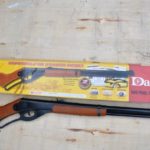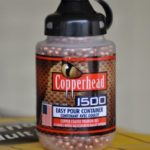
An American icon
I have no idea what happened to it, but the first honest-to-gosh gun I ever handled was a Daisy BB gun given to me by my dad on my sixth birthday.
My old man had the foresight and wisdom to start me early with a BB gun and set my feet on a path that has never moved from the sphere of shooting and guns.
I can’t remember how many BB guns I went through while growing up, but there were at least two Daisy Pump 25s — the iconic 50-shot repeater pump cockers that are still manufactured today. I cut my shooting teeth on a Daisy, and I suspect a large majority of shooters did the same over the years.
I walked into a local hardware store the other day, and there, hanging on the wall, was a Daisy Red Ryder BB gun — still manufactured like a saddle-ring carbine, still with the little strand of rawhide tied to its receiver, and the inscription of “Red Ryder” still embossed into the side of the wood stock.
You probably have to be old today to even remember the Red Ryder/Little Beaver comic strips of yesteryear, but generations of kids who never heard of the cowboy comic strip character and his juvenile Indian sidekick still learned to shoot with a Daisy Red Ryder BB gun.
I grew up as a baby boomer — the first generation removed from the farms as the United States transitioned from a mostly rural, agrarian society to a more-urban environment. Like a lot of kids, I was fortunate to have grandparents with a farm — in this case, a truck and dairy farm in rural Tangipahoa Parish, where I spent most of my time with a Daisy when not in school.
The company was originally founded as an iron windmill manufacturer, and was failing in the 1880s when its founder introduced a metal air gun he had designed to the board of the windmill company.
The chairman of the board, upon test firing the gun, exclaimed, “That’s a daisy!” and the name stuck.
The company moved to Rogers, Ark., in 1958 and remains in that city today, a premier manufacturer of air guns, pistols and rifles still.
There’s an old saying about putting up the things of a child and taking up the things of a man — but I carried BB guns a lot longer than most would expect. The doggone things are just so much fun and so safe to use — even as a teenager, when a .22 rifle or a shotgun would be too much noise for the area, I could still have just as much fun shooting clothespins off a line, sparrows out of a garden or terrorizing the neighbor’s cats with a BB gun. The damage was slight, the noise negligible and the accuracy sufficient.
Growing up, I was a terror on dragonflies — one of my preferred targets. It became so easy shooting these fat-bodied, four-winged speedsters off fence wires that I wasn’t challenged unless I could take one’s head off, and leave the body and wings sitting, clasped to the strands of barbed wire as if prepared for eternal takeoff.
I was tickled during basic training in the Army to be taught “lead” and shooting at moving targets with adult-sized Daisy BB guns, manufactured for the military with lengthened stocks and no sights. We were quickly taught to hit aluminum discs tossed in the air in front of the shooters. Soldiers with no experience with guns whatsoever were taught they could snap-shoot using their eyes and reflexes and hit small round discs — thus gaining confidence in their own gun-handling abilities.
I kept a BB gun around the house for years to run off recalcitrant cats and other beasts that aggravated our own pets when we lived in the city. The quiet “phfffft” sound of compressed air escaping behind a .177 steel ball was guaranteed not to get the neighbors up in arms (so to speak), and the BB would sting any feral traveler attracted to our own pets’ food bowls.
And I continued a tradition that began with my childhood by setting up cardboard boxes in the backyard of our home, stapling targets to them, and teaching my small kids gun safety and proper sight usage without fear of disturbing neighbors.
I suspect I will continue this training now with the crop of grandkids coming along.
BB guns like the Red Ryder and Daisy Pump 25 compress air by use of a piston that is released when the trigger is pulled. The compressed air is forced into a chamber behind a steel ball (the BB), which is then forced down a barrel with ample accuracy to hit very small targets up to 20 feet away.
My all-time favorite was the Daisy Pump 25, and I wore out at least two of these, shooting thousands of BBs through them over the years. Daisy says it is probably the most-requested model ever made, and was manufactured from 1914 until 1978. It was brought back as a centennial commemorative edition in 1986, and finally brought out of retirement and added back to the full product line in 2007.
I had a bit of déjà vu looking over the Daisy online catalogue and reading about this venerable model, which features a wood stock and foregrip, and a 50-shot screw-in shot tube — the new, modern tubes will still fit the antique models if you have one laying around.
In fact, I think I am going to throw a bit of business to my local hardware store — which is only fitting since probably a huge chunk of Daisy air guns were sold in small-town hardware stores back in the day when the hardware store or Western Auto (remember those?) was the local gun store.
It seems fitting to go to a place that has a Red Ryder air gun hanging on the wall and ordering a new Daisy Pump 25 or two. Or better yet, take grandkids to that most wondrous of places, and let them look on wide-eyed as two men handle a toy that is not a toy with reverence and fond memories, and then afterward take those same small children out with that BB gun, and introduce them to the joys of shooting.
Just like I was introduced all those decades ago.




